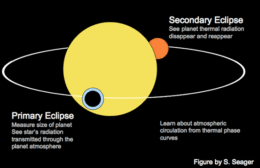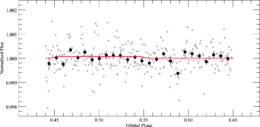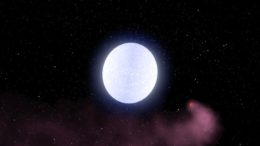What’s the atmosphere like on the hottest planet we’ve ever discovered? A new study suggests this toasty world may also be cloudless.
Hotter and Hotter
More than two decades ago, the discovery of the first hot Jupiters — gas giant exoplanets that orbit extremely close to their host stars — signaled that other solar systems may host very different planets than our own. Since then, we’ve discovered a whole zoo of unusual planets — including ever hotter Jupiters.
Thus far, Kelt-9b holds the record. This scalding giant orbits once every 1.49 days while its 10,000-K host blasts it with ultraviolet radiation. Its dayside temperature (Kelt-9b is tidally locked, so the same side always faces its host) is somewhere between 4,000–4,600 K — which is hotter than many stars.Under these extreme conditions, what is Kelt-9b’s atmosphere like? Is it similar to its slightly cooler hot-Jupiter cousins? Or do the extreme temperatures lead to unusual features? To learn more, our best bet is to watch this planet disappear.
Vanishing Light

Schematic of the primary and secondary eclipses that occur when a transiting exoplanet orbits its host. [S. Seager]
- The thermal light emitted by the planet is blocked out when it ducks behind its host.
- The light the planet reflects from its host star is blocked out as the planet transits behind the star.
In a new study, a team of scientists led by Matthew Hooton (Queen’s University Belfast, UK) has explored Kelt-9b’s secondary eclipse in near-UV wavelengths to learn more about this extremely hot Jupiter.
Constraints from a Missing Dip
Intriguingly, Hooton and collaborators found no evidence for a dip in the UV light curve when Kelt-9b passed behind its host. This non-detection reveals quite a bit of information, allowing us to place limits on the planet’s dayside temperature and the amount of UV light that it reflects.

Ultraviolet light curve for Kelt-9b as it transits behind its host. Unbinned data is shown in gray, binned data in black. The best-fit eclipse model, shown in red, indicates that no eclipse is evident in the data. [Hooton et al. 2018]
Looking to the Future
The authors’ study marks another important capability. Previously, all studies exploring reflected light of transiting exoplanets were conducted with space-based telescopes like Hubble or Kepler. But Hooton and collaborators made their observations of Kelt-9b with the ground-based 2.5-m Isaac Newton Telescope at the Roque de los Muchachos Observatory in the Canary Islands.
Since the only suitable space-based near-UV coverage right now is provided by Hubble — which won’t be around forever — it’s an important outcome that a ground-based telescope has proven capable of making these measurements. Hooton and collaborators’ work demonstrates that even when Hubble is no longer an option, we will still be able to obtain valuable observations of bizarre planets like Kelt-9b.
Citation
“A Ground-based Near-ultraviolet Secondary Eclipse Observation of KELT-9b,” Matthew J. Hooton et al 2018 ApJL 869 L25. doi:10.3847/2041-8213/aaf6a9


7 Comments
Pingback: AAS Nova – New
Pingback: Daily Study Log (2019-01-25) | Study Astrophysics
Pingback: Eclipses de un planeta abrasador – Observatori Astronòmic
Pingback: Eclipses de un planeta abrasador « SEDA / LIADA - RedLIADA - Cursos LIADA - Cielo del Mes - Fenómenos Astronómicos - RELEA
Pingback: Eclipses de un planeta abrasador | Sección de Exoplanetas - Planetas extrasolares / LIADA Liga Iberoamericana de Astronomía
Pingback: Febrero 2019 – Observatori Astronòmic
Pingback: Let’s talk about Exoplanetary Photospheres | astrobites